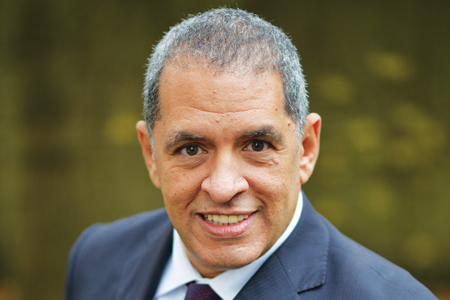
Here in the Middle East, development trends and shifts this year are creating new opportunities for companies to do business in new territory and achieve a first-mover advantage, as well as in nearby areas where Middle East investors have recently been major foreign players, like Africa and South Asia.
In Q1 2018, Asia-Middle East container volumes spiked 26%, hinting at an enormous volume of trade that can be better supported by satellite solutions. Airlines saw passenger traffic rise 4.2% for the year. PwC called 2018 “the best in five years for Middle Eastern oil exporters” and noted that “stronger prices, combined with… reforms… put these economies on a more stable footing for 2019”.
Underpinning this growth is a steady rise in connectivity and technology upgrading. The industry is benefiting from heavy investment in FTTH and 4G LTE, with 5G just around the corner. Over 67% of the Middle East was connected to the internet by the end of Q3 2017, but broadband penetration is highly uneven.
Here are five key trends we expect to see in 2019:
Economic transformation drives use of satellite solutions
Oil leaders are diversifying their economies and satellite will play a pivotal role in this transformation through cloud connectivity and IoT. The need for government services, which satellite is well-suited for, is also increasing, such as the UAE’s m-Government project. The benefits are not just enhanced connectivity: a leader at Smart Dubai notes that the government saves AED 5 for every AED 1 invested in the programme. Satellite is a key partner for governments in building secure and reliable connectivity.
Industrial demand for satellite-enabled IoT to rise
According to IDC, global spending on IoT is forecast to hit $1.2tn by 2022. Proof-of-concepts are now being transformed into integrated solutions offered by IoT technology vendors and satellite-enabled service providers, enabling companies to operate in remote locations to deploy IoT applications and services. This will open up the IoT opportunity for governments and vertical industries in areas where connectivity has traditionally been non-existent or poor – for example, industrial IoT services on oil rigs, mining sites and energy farms.Satellite-based IoT with fibre-like performance will allow companies to send large amounts of data to the cloud or the edge, for real-time processing and analytics. This will present significant opportunities for cloud providers to tap into a wide range of organisations across governments and different market segments looking to use IoT.
Smart cities and digitisation spur 5G rollout
A GSMA Intelligence report released in late November predicts that all six GCC economies will roll out 5G services within the next five years.
Saudi Arabia, Jordan and the UAE are the highest ranked in MENA in terms of digital capability.
As 5G news heats up around the world, the satellite industry’s investment in both space and ground assets will help accelerate 5G deployment. Using satellite’s global reach, new constellations delivering 5G-ready services will enable mobile network operators (MNOs) to expand their footprint with high capacity and low latency in remote and underserved areas.
Another driver for 5G is investment in new smart cities and future demonstration zones, such as Saudi Arabia’s Neom, Sharjah’s Aljada, Oman’s Madinat al Irfan and, of course, Dubai and Abu Dhabi.
Airline and cruise industry customers drive demand for seamless Wi-Fi connectivity
Despite missing its target of 90 million passengers in 2018, Dubai remains one of the world’s busiest airports. The same demand comes at sea, particularly from cruise ships, superyachts and vessels plying the Gulf and major trade routes in the Red Sea and Indian Ocean. Advanced hybrid satellite technology consisting of GEO and MEO fleets is key to providing an unmatched guest experience, which increasingly depends on reliable high-capacity broadband connectivity.
The ‘home away from home’ super-high-speed connectivity experience ties in particularly well, as several Middle Eastern countries have been investing heavily in cruise port infrastructure and cruise operators are expanding regional route offerings rapidly. Operators see the region as a good home for European fleets in winter, while travellers see MENA itineraries as an easy way to check off several countries while enjoying a premium experience that necessitates a high-performance internet connection.
Network automation, virtualisation through use of hybrid satellite fleets
Telco operators are constantly seeking ways to drive new revenue streams and fulfil local government requirements to connect their citizens. As satellite network operations and service delivery become more automated and standards-driven, telco operators will benefit from faster service activation, more intelligent, efficient use of capacity, and easier integration into their broader network infrastructure.
In summary, in 2019 the satellite industry will be growing its cloud-scale data networking capabilities by launching satellites in multiple orbits. More MEO satellites will be launched and other non-GEO systems operators will be talking up future constellations. Traditional GEO satellite operators will continue reinventing themselves with high-throughput satellites (HTS). In MENA alone, demand for HTS capacity is expected to increase from 40Gbps in 2019 to over 770Gbps in 2027, mainly driven by non-geostationary HTS demand. This is almost 60% of the global HTS demand in 2027, according to NSR.
Integral to HTS, spot beam technology is designed to provide greater capacity and high data rates ideally suited to enterprise and consumer broadband applications that require data-intensive usage within a smaller vicinity. It is more cost-effective and allows telcos to remain price-competitive.
In a world defined by IoT and cloud-based connectivity, satellite will be the key complement to terrestrial infrastructure, with end users benefiting as we create new opportunities through satellite-enabled managed data services.
Hussein Oteifa is GM at SES Middle East.













Add Comment